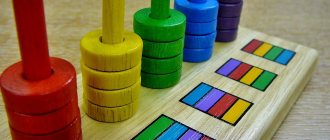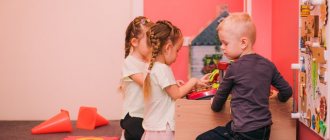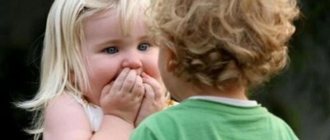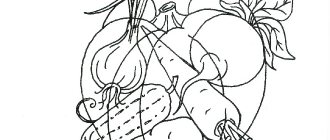Features of vocabulary formation in preschoolers
After listening to a preschooler, you can very quickly determine how rich his vocabulary is, and how the child’s grammatical structure of speech is formed. Each age period corresponds to a certain speech level. A child’s achievements depend on how much attention parents and educators pay to this issue.
Approaching preschool age - by the age of 3 - the child knows most of the words that adults address to him. The baby does not pronounce all of them, but he understands what is being said to him.
Basically, this is still a passive dictionary. But gradually the child masters pronunciation and uses, albeit in a peculiar sound, word after word in his speech.
The formation of vocabulary in preschool children occurs somewhat differently than in schoolchildren. Older children add new concepts to their vocabulary, which they already have quite solid. Preschoolers have yet to reach this level.
First, they need to comprehend words at different levels of generalization. Try telling a 3-year-old child, pointing to his doll or little car: “What a beautiful toy you have!” And the baby will definitely correct you: “This is a doll (car)!”
For a younger preschooler, each word acts as the name of its own separate object or phenomenon. He still doesn’t understand how a doll can be called a toy. And all because the peculiarities of vocabulary formation in preschool age consist in the consistent acquisition of the meaning of the words used.
Stages of mastering the semantic content of a word
The issue of a child’s consistent comprehension of words is very well covered by Doctor of Medical Sciences, Professor of the Academy of Education M.M. Koltsovaya. Let's take a brief look at what levels of verbal generalization a preschooler will have to overcome.
- The child understands the word as referring to a specific object known to him. A cup is the name of that convenient item from which the baby drinks milk and juice. The bunny is that soft pink lump that sits next to the doll. Boots are what you put on your baby's feet. There are no other cups, bunnies or shoes for a child, since a strong connection has been established between the child and specific objects. This is the stage of early comprehension of a word, lasting up to about 1.5 years, and even longer in the perception of new words.
- The meaning of the word becomes broader. The child already understands that other people eat with spoons, not just him. There are many cars, apples are different, and other children and even adults may have shoes. That is, the word already denotes a group of objects. This level of comprehension is available to a 2-year-old child if speech development corresponds to the norm.
- A qualitative breakthrough occurs after 3 years and is manifested in the fact that the preschooler begins to combine some accessible concepts into more general groups. Mom calls a tasty apple, pear and orange fruit, and the child gradually remembers this new concept. Further comprehension tells the child that banana can also be included in this list. The preschooler already calls all his play objects toys. At this stage there is no end to the work. We need to comprehend new categories: furniture, transport, clothing, pets, wild animals...
- A preschooler begins to perceive generalized concepts that include several smaller groups (plants, things, natural phenomena, etc.) only from the age of 5. Understanding the semantic meaning of such general concepts requires logical thinking. A high degree of generalization is too distant from real sensations, and systematic work is required for a preschooler to include general concepts in his vocabulary.
The statements of some developed children under 5 years of age may sometimes contain general concepts: “My things,” “We saw a beautiful plant.” But it is enough to ask a preschooler a few questions and it becomes obvious that he uses these words in a narrow sense.
Conversations
From the age of 3, the child already understands the meaning of the text and understands the content of poems and fairy tales that his mother reads to him. Therefore, you can discuss the books you read or the illustrations you viewed. Effective exercises:
- the child tells what is shown in the pictures and makes up stories based on them;
- the child answers questions based on the text he just listened to (good questions: who did you like best? what event do you remember? what would you do in the hero’s place? why?);
- the child describes an object in detail (parents can ask clarifying questions: what shape is it? what color?).
To learn the names of body parts and items of clothing, have your child describe himself or a doll.
Reading fiction
Be sure to read aloud to your child. After all, reading fiction is the most important way to enrich your vocabulary. Children who have loved books since childhood have more developed speech than their peers, are able to construct sentences correctly, and write essays better in school.
When reading a book to your child, try to pronounce words clearly, loudly and correctly, and avoid mistakes in articulation and emphasis. If there are unfamiliar words in the text, explain their meaning to the baby.
Active and passive vocabulary of a preschooler
In the stock of words already known to the child, there are active and passive vocabulary. A baby may respond correctly to a certain word, but not even try to pronounce it. In this case, the word is a passive. For example, a child understands and responds to the instruction “Take,” but until middle preschool age this word is unlikely to appear in his speech. Moreover, there is such a simple and understandable “Here!”
A 3-year-old vocabulary should ideally include 1-1.5 thousand words, and it already includes all parts of speech. But only some of them are actively used by the child.
Active vocabulary involves mastering the meaning of words and applying them to their place and logical connection.
During the preschool years, a child's vocabulary at least triples. The active vocabulary should use most of this stock. That is, the preschooler uses in everyday life the predominant number of words that he knows.
Enriching the vocabulary of preschoolers
Based on the presented description of the stages of understanding concepts, it follows that the development of the vocabulary of children of primary preschool age occurs due to the frequent use of the same words and the addition of new ones. All parents teach their children to name objects and actions.
To help a child comprehend words as a second-level generalization, one must be given the opportunity to touch objects and act with them. It is important to establish as many conditional connections as possible. It is necessary to encourage action: take it, give it to me, turn it, open it, close it, etc. At the same time, you should say a new word repeatedly. For example, “take the pencil case”, “open the pencil case”, “what do you want to put in the pencil case?” This is how the word turns into a meaningful concept and is fixed in the memory of the preschooler.
It is necessary to move to the next level of generalization already in early preschool age. When spending time with your child, it is important to use any environment to increase his awareness.
For example, when pointing to a trolleybus, you need to note not only its “horns”, but also call it the general concept of transport. Immediately give an example of another type of transport and repeat it with your child. And practice this way with each group of concepts.
The development of the vocabulary of preschool children occurs through common and easily implemented methods:
- mastering new concepts
- consolidation of generalizing words
- use of associative series
If you stop using the word as a generalization, then very soon the preschooler will narrow its meaning. For example, a sofa will be considered furniture, while tables and chairs will remain apart; He will classify the usual cucumber and tomato as vegetables, but will forget about onions and beets.
The use of associative connections fills a child’s vocabulary well. “What kind of car do you have?” - and the preschooler begins to describe: “Beautiful, new, goes fast, with a body, blue...”. The more characteristics of any concept adults list, the more words will appear in the child’s descriptive speech.
Don't lose sight of your preschooler's verb vocabulary. It is harmful to perform actions in the presence of a child in silence! There is nothing difficult about talking through each step. Mom can silently lay out the cutlery and only say: “Now we’ll eat.” But nothing prevents you from voicing the whole process: “Let’s put a plate, pour some soup into the plate, put a spoon next to it, and now we’ll sit down to eat.” These methods are extremely simple, but very effective for speech development at 3-4 years old.
It seems to adults that these are completely ordinary words that the child will sooner or later master. And for a child, this is necessary material for replenishing his active vocabulary.
Techniques for developing vocabulary for older preschool children
As the child grows up, it is necessary to complicate and increase the verbal load. It is necessary to use new concepts more and more in speech, explain their meaning to children, and after some time ask about the meaning of new words. It is also important to complicate the content and form of the sentence, showing the preschooler an example of the use of words in speech.
6-year-old children should have a vocabulary of more than 3,000 words. At this age, the preschooler comprehends concepts related to time periods and spatial orientation, and is interested in abstract concepts.
Ways to develop the vocabulary of an older preschooler:
- Ask the child to explain how he understands the meaning of the word. In such explanations, children rely on the functional characteristics of the object and better remember new concepts (jump rope - a rope that they jump over; a meat grinder - chops meat into small pieces, etc.)
- Look for connections with already known concepts and classify them as a general group (turkey is a bird, a domestic animal)
- Introduce the preschooler to different meanings of words (homonymous series: braid, brush, ring, car, bow, etc.)
- Form comparative degrees of adjectives (tall - higher, beautiful - more beautiful, good - better)
- Pay attention to new words when reading fairy tales and other children's literature: explain the meaning, offer to repeat the word.
At preschool age, the core of the vocabulary is formed, which is also used by adults. If you miss this sensitive period, it will not be easy to catch up in the child’s speech development. People don't just speak with words. They think and reflect with their help. Expanding a preschooler's vocabulary means not only increasing his awareness, but also developing his thinking.
Observation with comments
From the very birth of the baby, start talking to him: the baby must get used to the sound of human speech. Lesson options:
- While walking, tell your baby everything you see. Try to make the story picturesque and figurative: use many adjectives, use synonyms. An example of a good description: “This is a tree. It is green, bright, with lush foliage. And how big, tall and majestic it is! This is a truly gigantic tree!” Try to comment on events emotionally: say how you feel from contemplating a rainbow or how you feel when a hot object touches your hand.
- An eight-month-old child can already be taught about the structure of the body. Touch it and say: “This is a pen, your pen; little pink hand." Then show your hand and say: “This is my hand: look how big it is.” Remember to use as many adjectives as possible.
- Organize a joint observation of something: a pet, an insect, a tree swaying in the wind, or something happening on the street. At the same time, comment on what is happening: “Look, a grasshopper is crawling along a leaf. Now he moved his paw. Funny, isn't it? Oh, that’s it, he galloped away.” If possible, let your child touch, smell, or even lick the observed object.
- You can conduct several experiments with your child. Bring his hand to the cat’s fur and say: “This is a cat; It’s soft, warm and smooth.” Then invite the baby to hold a piece of ice and say: “This is cold, hard and wet ice.”
- From the age of 2, you can purposefully introduce new lexical units into your child’s vocabulary. To do this, you must demonstrate the object to the child, say its name several times and make sure that the baby remembers it. Try to do it naturally. On a walk, as if by the way, show him a tree and say: “This is a spruce.” Point to another spruce and say again: “And this is a spruce.” Then, pointing to the tree, ask: “Do you think this is a spruce?” To make sure that your child remembers the word, point to the spruce and ask: “What kind of tree is this?”






